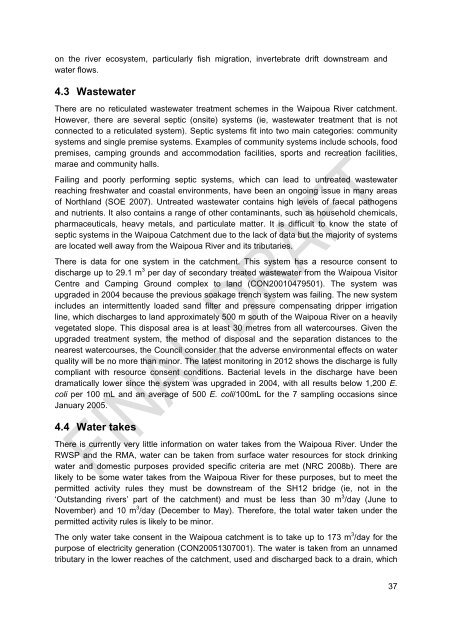Waipoua River 20130219.pdf - Northland Regional Council
Waipoua River 20130219.pdf - Northland Regional Council
Waipoua River 20130219.pdf - Northland Regional Council
- No tags were found...
Create successful ePaper yourself
Turn your PDF publications into a flip-book with our unique Google optimized e-Paper software.
on the river ecosystem, particularly fish migration, invertebrate drift downstream andwater flows.4.3 WastewaterThere are no reticulated wastewater treatment schemes in the <strong>Waipoua</strong> <strong>River</strong> catchment.However, there are several septic (onsite) systems (ie, wastewater treatment that is notconnected to a reticulated system). Septic systems fit into two main categories: communitysystems and single premise systems. Examples of community systems include schools, foodpremises, camping grounds and accommodation facilities, sports and recreation facilities,marae and community halls.Failing and poorly performing septic systems, which can lead to untreated wastewaterreaching freshwater and coastal environments, have been an ongoing issue in many areasof <strong>Northland</strong> (SOE 2007). Untreated wastewater contains high levels of faecal pathogensand nutrients. It also contains a range of other contaminants, such as household chemicals,pharmaceuticals, heavy metals, and particulate matter. It is difficult to know the state ofseptic systems in the <strong>Waipoua</strong> Catchment due to the lack of data but the majority of systemsare located well away from the <strong>Waipoua</strong> <strong>River</strong> and its tributaries.There is data for one system in the catchment. This system has a resource consent todischarge up to 29.1 m 3 per day of secondary treated wastewater from the <strong>Waipoua</strong> VisitorCentre and Camping Ground complex to land (CON20010479501). The system wasupgraded in 2004 because the previous soakage trench system was failing. The new systemincludes an intermittently loaded sand filter and pressure compensating dripper irrigationline, which discharges to land approximately 500 m south of the <strong>Waipoua</strong> <strong>River</strong> on a heavilyvegetated slope. This disposal area is at least 30 metres from all watercourses. Given theupgraded treatment system, the method of disposal and the separation distances to thenearest watercourses, the <strong>Council</strong> consider that the adverse environmental effects on waterquality will be no more than minor. The latest monitoring in 2012 shows the discharge is fullycompliant with resource consent conditions. Bacterial levels in the discharge have beendramatically lower since the system was upgraded in 2004, with all results below 1,200 E.coli per 100 mL and an average of 500 E. coli/100mL for the 7 sampling occasions sinceJanuary 2005.4.4 Water takesThere is currently very little information on water takes from the <strong>Waipoua</strong> <strong>River</strong>. Under theRWSP and the RMA, water can be taken from surface water resources for stock drinkingwater and domestic purposes provided specific criteria are met (NRC 2008b). There arelikely to be some water takes from the <strong>Waipoua</strong> <strong>River</strong> for these purposes, but to meet thepermitted activity rules they must be downstream of the SH12 bridge (ie, not in the‘Outstanding rivers’ part of the catchment) and must be less than 30 m 3 /day (June toNovember) and 10 m 3 /day (December to May). Therefore, the total water taken under thepermitted activity rules is likely to be minor.The only water take consent in the <strong>Waipoua</strong> catchment is to take up to 173 m 3 /day for thepurpose of electricity generation (CON20051307001). The water is taken from an unnamedtributary in the lower reaches of the catchment, used and discharged back to a drain, which37
















